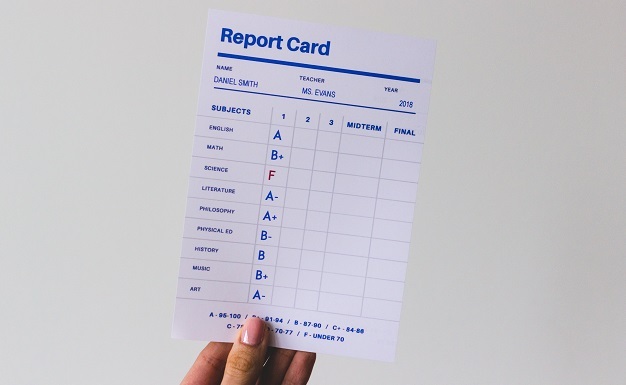
 Data Structure
Data Structure Networking
Networking RDBMS
RDBMS Operating System
Operating System Java
Java MS Excel
MS Excel iOS
iOS HTML
HTML CSS
CSS Android
Android Python
Python C Programming
C Programming C++
C++ C#
C# MongoDB
MongoDB MySQL
MySQL Javascript
Javascript PHP
PHP
- Selected Reading
- UPSC IAS Exams Notes
- Developer's Best Practices
- Questions and Answers
- Effective Resume Writing
- HR Interview Questions
- Computer Glossary
- Who is Who
What is the full form of GPA?
Introduction
Grade Point Average (GPA) measures student's accomplishment, which is employed by educational institutions.

The majority of the time, grades are averaged together and weighted based on the course difficulty before being used to determine the student's GPA.
Introduction
Grade Point Average, or GPA, is its full name. The term "GPA" refers to a system of education grades used to assess a student's academic achievement in high school and college. It is a numerical score that offers a concise overview of the key elements of the student's academic performance or reflection over the course of a school year.
Different scales are used to measure GPA at various kinds of educational institutions. The measure is presented in certain schools on a scale of 1-5, whereas in other schools it is presented on a scale of 1-10. The sum of all final grades obtained for a topic, course, or academic performance throughout time is the GPA.
Importance of GPA
Many firms have utilised GPA to accurately determine if an applicant is qualified and suitable for a vocation.
Separating the academic GPA from the outcomes for selection procedures during the interview is a common problem for these firms.
A candidate's success cannot be determined by GPA. It may be used to assess the applicant's performance and assessment.
There is no connection between an employee's performance and their GPA, according to recent assessments and research on GPA.
Benefits of GPA
The education grading system has lessened the pressure of ranking for students, enabling them to learn stress-free.
The education grade category is based on a sophisticated categorization scheme.
Learners can determine their strengths and shortcomings with the aid of the education rankings system.
The educational grading scale has simplified and increased the clarity of studies in numerous ways.
GPA calculation
Your grade point average (GPA) is derived by dividing your cumulative grade point total by your cumulative credit total.
Each letter grade receives a certain number of grade points: A receives four, B receives three, C receives two, D receives one, and F receives zero.
Use the following algorithm to determine your GPA: GPA = Grade Points Earned - Grade Points Potential
For instance, if you had a 97 in arithmetic but the course's maximum grade point total is 100, your maths GPA would be 97/100, or 0.97.
GPA conversion
One of the most significant variables that universities take into account when deciding who to admit is grade point average (GPA).

Your grade point average (GPA) is a reflection of your academic success and how well you have performed in school. Divide your GPA by 100 to get your GPA as a percentage.
Limitations of GPA
The educational rating system places lower expectations on kids' performance.
The education grading norm demotivates students who perform better than those who contribute less since they are assigned percentage grades on an equal footing.
As the educational grading standard has split the marks of several activities, including assignments, presentations, and final examinations, there is an increase in ignorance because of students' laziness.
The education grading system does a terrible job of providing accurate results for pupils.
University Grading System in India
In India, universities play a significant role in higher education. States in India's universities may have different grading systems. Universities in India, both public and private, use several grading systems. Here are several well-known institutions and their grading procedures
Traditional Grading System
Grades are expressed as percentages in India.According to the percentage reached, the following criteria are defined
Percentage |
Academic division |
|---|---|
75% and above |
Distinction |
60% to 74% |
1st Division |
50% to 59% |
2nd Division |
40% to 49% |
3rd Division |
UGC Grade scale
The University Grants Commission of India was founded by the Department of Higher Education, Ministry of Education, Government of India in accordance with the UGC Act 1956 as a statutory institution with the duty of organising, creating, and maintaining the standards of higher education. UGC uses the following grading methodology
Percentage Marks |
Grade Point |
Grade |
|---|---|---|
97.0-100 |
10 |
O |
87.0-96.9 |
9.0-9.9 |
A+ |
77.0-86.9 |
8.0-8.9 |
A |
67.0-76.9 |
7.0-7.9 |
B+ |
57.0-66.9 |
6.0-6.9 |
B |
47.0-56.9 |
5.0-5.9 |
C |
37.0-46.9 |
4.0-4.9 |
P |
Below 37.0 |
0 |
F |
Absent |
0 |
Ab |
Difference Between Overall GPA and Cumulative GPA
Your high school career's overall average grade is calculated as your grade point average, or GPA. Your Cumulative GPA only includes grades from classes you've taken since you began high school, but your Overall GPA includes every grade you've ever gotten in any class.
Some institutions will take the difficulty of the various coursework into consideration when weighing your GPA. An A in an AP or IB class, for instance, can be worth more than an ordinary A. We refer to this as a weighted GPA. Since grades aren't taken into account at other institutions, an A is always worth the same number of points.
Conclusion
Different institutions and colleges use different scales to determine GPA. Some rate it on a scale of 1 to 5, while others determine the grade on a scale of 1 to 10. Not to mention, your GPA is the average grade you received in each of your classes for the semester, year, and year. Accordingly, your grade may fluctuate during the course of your course and after it, depending on how well you develop over the course of the year.
FAQs
Q1 - What does GPA mean?
Ans The phrase "grade point average" is the official name of GPA. It is normally computed by adding up all of your numerical grades and dividing that total by the amount of academic credits you have taken this semester. The quantity of grades you will obtain during the semester will be totaled up and divided to give you a desirable average.
Q2 - How is the semester GPA determined?
Ans You must first multiply the number of credits each class is worth by the number of points you received for the letter grade you received in that class, coupled with the percentage of attendance, in order to determine your grade point average. Next, divide your cumulative grade point total for the semester by the number of credit hours you attempted. Most often, the institution will perform these computations; nonetheless, every student may perform them with ease.
Q3 - How can you improve your GPA?
Ans Try to make it through every class without missing any. Because simply being present can help you and slightly raise your score. Then it's also crucial to study effectively for your tests. The Vedantu website offers a tonne of previous year's question papers and sample question papers so users may practise working out under professional supervision. These papers also come with solutions so users can cross- check and assess their performance. View every one of the available professional teachers' recorded videos for every topic and idea.

